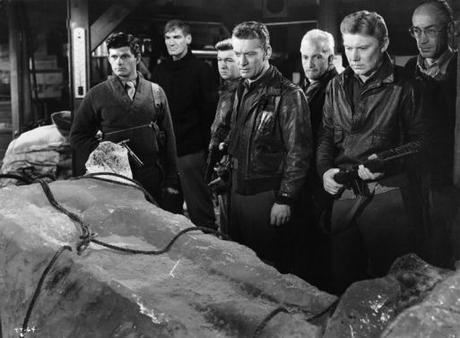 The Iceman cometh and went: Howard Hawks’ The Thing From Another World (RKO Pictures)
The Iceman cometh and went: Howard Hawks’ The Thing From Another World (RKO Pictures)One is an old Cold War relic, the other a modern-esque tale of paranoia run rampant. Which is “better”? And which is the more “relevant,” in terms of translating the original source material into a viable shocker for present-day movie audiences?
These are good points to ponder, but do we have an answer? No, but it’s worth spending a little time on the relative merits of these two equally effective science-fiction classics: RKO Radio Pictures’ The Thing From Another World released in 1951, and Universal’s The Thing from 1982. Both pictures address the theme of overly-aggressive visitors from outer space; both attribute their themes to issues prevalent at the time of their release; and both require their ensembles casts to come up with ingenious solutions to the problems presented by unfriendly aliens.
In addition to the above criteria, there is the presumption throughout that science, for all the sanity and wisdom it has imparted to explaining the unexplainable, is simply incapable of overcoming the complexities that humanity will face when confronted by factors beyond their knowledge or control.
The Thing From Another World (1951)
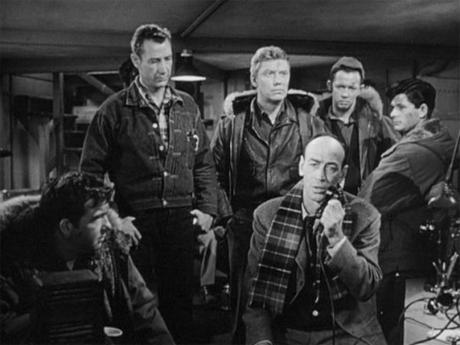
The premise: A flying saucer is found frozen in the Arctic Polar Region. Alerted to its presence, a salvage team of American research scientists, along with various military types, head out to the icy tundra in order to intercept and retrieve it.
In attempting to free the saucer from the permafrost, the military accidentally destroy the ship, only to discover that the alien passenger onboard has been flung into the ice. Instantly frozen by the subzero temperatures, the alien is rescued, in a manner of speaking, and brought to the scientists’ compound, with an around-the-clock guard keeping close tabs on the block of ice.
Unfortunately for the guard on duty, he places an electric blanket over the block so as not to gaze at the loathsome visitor’s creepy eyes, not realizing that the blanket’s warmth melts the surrounding ice. Within hours, the creature escapes the compound and goes on a violent rampage in order to preserve its kind.
A quintessential fifties sci-fi thriller, The Thing From Another World eerily mirrors the gathering Communist storm — and existential threat of that era — by echoing the American response to it. In addition to which, it took into account the increasingly frequent UFO sightings made after 1947. The film is in director Howard Hawk’s inimitable “chatty” style, i.e., abounding in overlapping dialog with staccato delivery, spoken by a predominantly male cast and the lone wise-cracking female scientist (now there’s a modern angle to boast of). Although the direction is credited to Hawks’ assistant, Christian Nyby, the style is unmistakably that of the veteran of such classic pictures as The Big Sleep, His Girl Friday, and Red River.
The film provides a fair amount of suspense — the creature’s nighttime attack, and its being doused with flame throwers and gasoline buckets, as well as the claustrophobic surroundings, are major assets —but it’s too timid in its execution to furnish more than casual thrills.
Certainly the Frankenstein-monster getup for the alien invader is an egregious faux pas. The Thing, played by six foot seven inch James Arness (Them, Gunsmoke) in his salad days, is nowhere near as frightening or repugnant as it ought to be, considering the source material, John W. Campbell’s 1938 short story, “Who Goes There?” and how it’s described on the screen. Apparently, the less one sees of The Thing, the scarier and more intense things get (no pun intended).
The camaraderie and forced bravado of the military men, for example, along with their testosterone-fueled tendencies toward combating the wily creature, are, quite naturally, understandable, in view of the times in which the film was made: science takes a back seat to sheer bluster and Yankee gung-ho ingenuity in addressing the impending peril. Just the thought of a blood-sucking alien vampire on the prowl, turning humans and sled dogs into lifeless carcasses in order to sustain a growing brood of “super carrots,” was enough to send movie audiences into a tailspin.
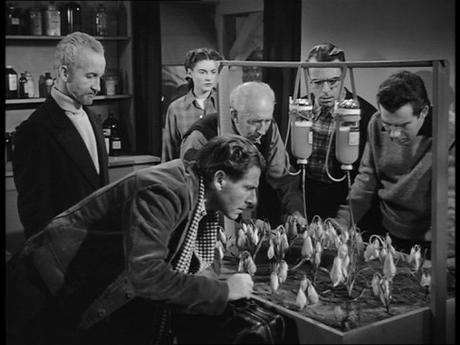
Carlos Clarens, in his An Illustrated History of Horror and Science Fiction Films, came up with a novel theory regarding his interpretation of The Thing from Another World: with reference to the creature’s intellectual superiority over his human counterparts, Clarens postulated that “omniscience does not mean human feelings, generosity, or understanding. In this respect, the film is something of a parable: superior science unencumbered by moral scruples will bleed us to death” (Clarens, p. 124).
He cites the example of chief scientist, Dr. Carrington (he’s very “caring,” if you know I mean), who argues for opening up communications with the alien being, only to be brushed aside not only by his fellow scientists and those itchy-trigger-fingered military men, but by the creature itself (violently so). As a matter of fact, the military treat Dr. Carrington a helluva lot better than The Thing does, which only proves the point.
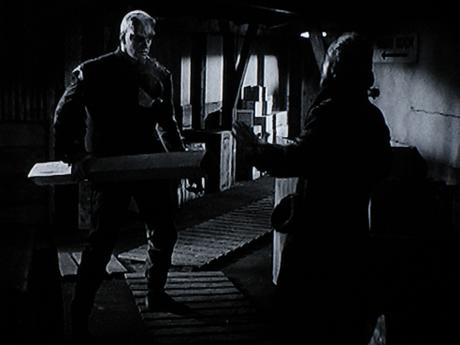
The great ensemble cast mentioned earlier features many familiar faces, among them the reliable Kenneth Tobey as Captain Pat Hendry, Margaret Sheridan as Nikki, Dewey Martin as Crew Chief Bob, Robert Cornthwaite as Dr. Carrington, George Fenneman as Dr. Redding, James Young as Lt. Dykes, John Dierkes as Dr. Chapman, William Self as Corporal Barnes, Eduard Franz as Dr. Stern, Paul Frees as Dr. Voorhees, and Douglas Spencer as “Scotty” the jocular newspaper man, whose final call to “Keep watching the skies” is a none-too-subtle alert against future Red menaces.
The eerie theremin-based film score is by Dimitri Tiomkin, and is in a category all its own. Although in our opinion it’s not the “classic of classics” some critics have made it out to be, I regard it as being very much like Puccini’s opera Tosca: it’s a “shabby little shocker” that still packs a tremendous wallop — when the titular Thing is out of plain sight, that is. And remember this, folks: Keep watching those not-so-friendly skies…!
The Thing (1982)
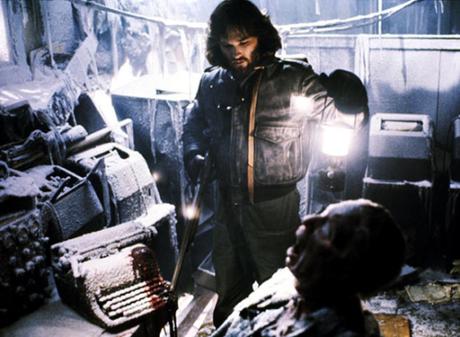
With Ridley Scott’s Alien (1979) having rejuvenated the vogue for chest-bursting monsters, doomed crew members, and outer-space horror flicks, director John Carpenter (Halloween, Escape from New York) undertook to remake that old fifties staple The Thing — this time with modern cinematic elements.
Carpenter returned to the original idea (the script was written by Bill Lancaster, actor Burt Lancaster’s son) of a shape-shifting alien being, suggested by sci-fi writer John W. Campbell’s short story, “Who Goes There?” (written under the pseudonym of Don A. Stuart). It told a terrifying tale of paranoia and loss of identity, long before the threat of Communism and invaders from Mars would “bug” us out.
However, after the real-life horrors of the Vietnam War, the ensuing Watergate scandals, and the revved up military spending spree vis-à-vis the Soviet Union, the 1982 remake of The Thing spoke solemnly to audiences of the mistrust inherent when individuals, charged with the responsibility of working together as a functioning unit, drop all semblance of so-called “civilized” society (see William Golding’s novel Lord of the Flies for a similar viewpoint) to let mindless fear, panic, and isolation seep into their existence.
The story takes place at an Antarctic research facility (scene of the original tale, by the way), where American scientists are investigating the strange deaths at a nearby abandoned Norwegian installation. An Alaskan malamute appears to be the only survivor. Taking the dog back to their compound, one of the scientists, Clark, pens it up with the other sled dogs — but they sense this is not one of their own. Before long, the Thing they have brought back gets loose and starts to take over the minds (and bodies) of the individual researchers. In no time, the researchers turn on one another until in the film’s final frame only two “survivors” are left to toast their troubles away.
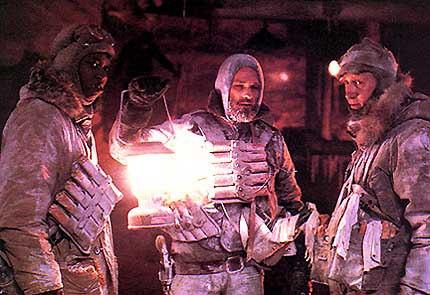
While faithful to the original work in cast and story line, and besides possessing top-notch special FX by the talented team of Rob Bottin and Stan Winston (using stop-motion techniques and animatronics), the film is so enamored of gore and viscera that it forgets to keep its mind on the main plot. The elements of fear and suspicion are present throughout, but there’s so little insight into the characters (and little if any background to them) that they serve as mere backdrops for the real showcase, i.e., those amazing transformation sequences.
Indeed, the creature that erupts all over the screen is without a doubt the vilest, most repulsive-looking Thing imaginable. It reminds one of a giant Venus flytrap. After a while, though, it even starts to take on the comic mannerisms of Audrey II, the “mean green mother from outer space,” in the hit musical The Little Shop of Horrors, which robs it of its ferocity.
Despite this mild handicap, in recent years the film has taken on the status of a cult favorite. At the time of its release, The Thing was in direct competition with the more benign E.T. the Extraterrestrial and Blade Runner. Movie critics eviscerated the work, which while tailored to mature audiences, is really an FX connoisseur’s dream come true (more like a nightmare).
The rugged, all-male cast is headed by Kurt Russell, at his swaggering best, as R.J. MacReady, Wilford Brimley sans his walrus mustache as the paranoid Blair, Richard Dysart as Dr. Cooper, Donald Moffat as Garry, Keith David as Childs, David Clennon as Palmer, Richard Masur as Clark, T.K. Carter as Nauls, Charles Hallahan as Norris, and Peter Maloney as Bennings. Gut-wrenching scenes, along with a dynamic, pulsating electronic score by composer Ennio Morricone, are the main pluses. The final confrontation between MacReady and Childs leaves it up to the viewer whether this Thing has been vanquished or not. It’s one of those truly nihilistic endings.

Strictly for lovers of elaborate effects, the Howard Hawks-produced version was much more fun than this deadly-straight, coldly distant, starkly dark rendition. But be warned: do not, by any means, let your kids see this alone (heck, I wouldn’t see it alone, either).
Copyright © 2017 by Josmar F. Lopes

